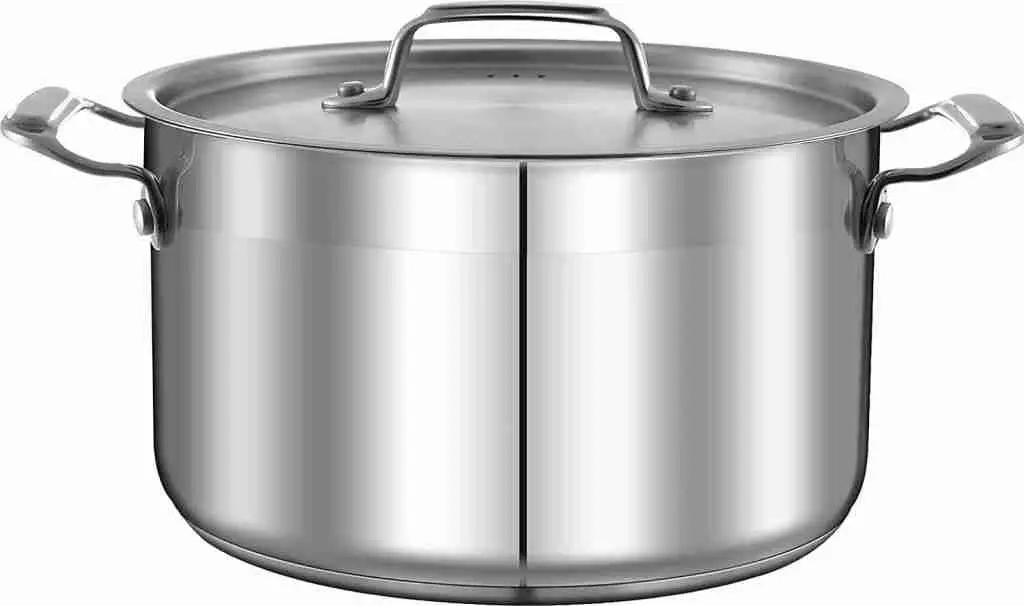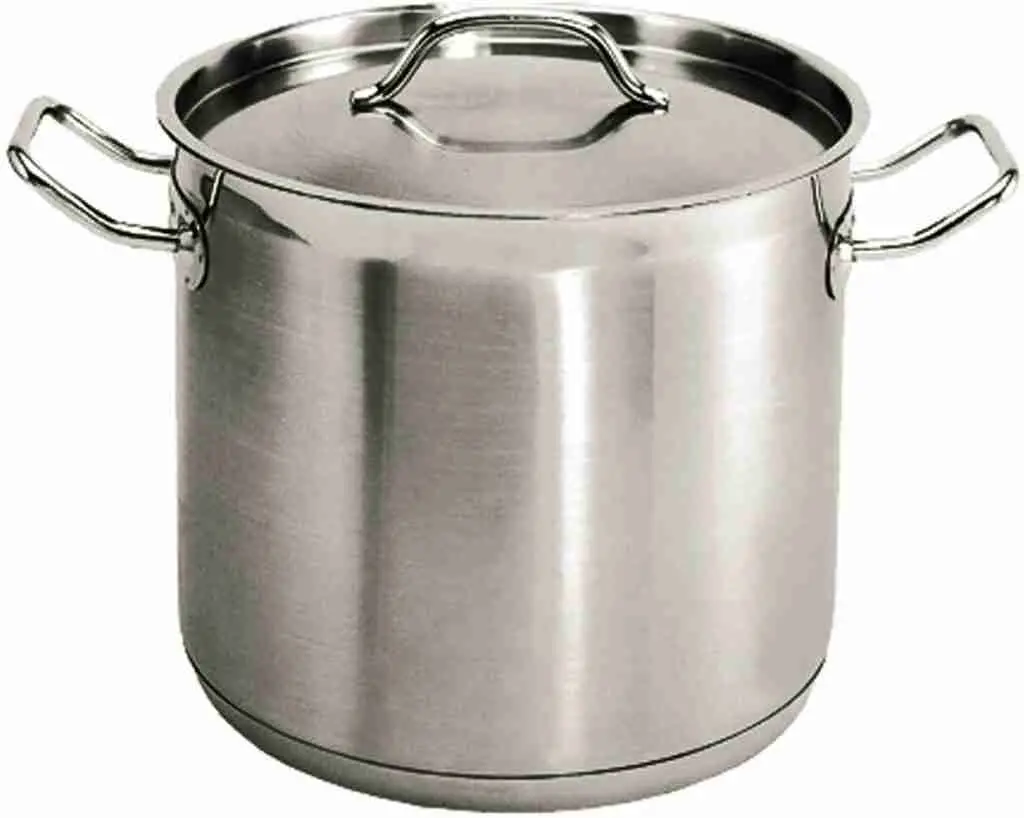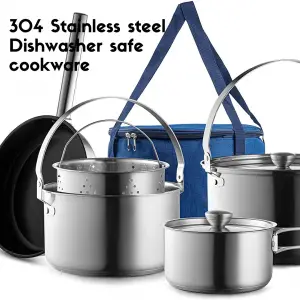I worked with a food beverage company for about 4 years, when you come in, one element you see is stainless steel. There is a reason why stainless steel is used in connection with food.
To begin, we have over 150 grades or varieties of stainless steel and each comes with pros and cons. The popular food grades of stainless steel are 316, 304, 200, and 430.
In this article, I will give an answer to the question: is 304 stainless steel food grade? Knowing this will help you to determine which one is best for you, your family, and your business.
Keep reading to find out the best stainless steel food grade.
IS ALL STAINLESS STEEL FOOD GRADE?
No, it is not all stainless steel that is labeled food grade or quality because it is not all grades that are resistant to corrosion and can withstand an acidic or salty environment over time.
It is vital to remember that we have over 150 different types of stainless steel, each with different qualities and variances that contribute to the diverse needs that these stainless steel food grades meet.
Stainless steel food grades include the 200 series, 304, 316, 430, and 440. The non-magnetic 300 Series, Grade 304, 18/8, and 18/10 stainless steel grades are the most commonly used for food preparation and dining.
IS 316 STAINLESS STEEL FOOD GRADE?
Yes, 316 stainless steel is the highest form of food grade because it has the best corrosion, acidic, and harsh chemical resistance.
BEST FOOD GRADE STAINLESS STEEL
The best food grade of stainless steel is the grade 316 alloy because it has a very high resistance to acids, alkalis, and chlorides such as salt. The 316 stainless steel food grade makes excellent stainless steel containers for nearly any food application.
Furthermore, the 316 stainless steel food grade is also known as 18/10 since it has 18% chromium and 10% nickel, which indicates it contains a high percentage of corrosion resistance.
Overall, food grade 316 is the best choice when producing food-grade stainless steel containers since it is more chemically resistant in a number of applications, particularly when dealing with salt and stronger acidic chemicals like lemon or tomato juice.
READ ALSO: IS 18/0 STAINLESS STEEL SAFE?
READ ALSO: IS 18/10 STAINLESS STEEL SAFE?
430 STAINLESS STEEL FOOD GRADE
To begin, the 430 stainless steel food grade classification is also known as 18/0, which implies it includes 18% chromium and 0% nickel.
Although the 430 stainless steel food grade lacks the same nickel ingredient as the 316 (18/10) stainless steel, it has considerable resistance to nitric and organic acids and is frequently employed in applications where prolonged contact with mildly acidic substances is a concern.
Furthermore, grade 430 stainless steel is a ferritic alloy, which means it is magnetic by default. Ferritic alloys, such as 430 stainless steel, offer exceptional resistance to stress corrosion cracking, which is the production of cracks that can cause rapid failure in corrosive situations.
Finally, 430 stainless steel food grade is a less expensive alternative to 316 (18/10) stainless steel food grade.
IS 304 STAINLESS STEEL FOOD GRADE?

Yes, 304 stainless steel is food grade because it can survive corrosion from most oxidizing acids and is simple to sterilize, making it perfect for many kitchen and food applications.
IS 304 STAINLESS STEEL MARINE GRADE?
No, 304 stainless steel is not marine grade since it lacks the ingredients required to survive marine environments or applications.
IS 304 STAINLESS STEEL MAGNETIC?
The 304 stainless steel grade isn’t magnetic but it can be when extra elements are added to the base for induction compatibility.
IS 304 STAINLESS STEEL NICKEL-FREE?
No, because it includes 8% nickel, the 304 stainless steel grade classification is not nickel-free.
IS 304 STAINLESS BETTER THAN 316
No, the 304 stainless steel grade is not superior to the 316 since it cannot withstand harsh corrosive environments as well as the 316, making the 316 the highest food grade type of stainless steel.
In other ways, the 316 stainless steel is better than the 304.
STAINLESS STEEL 201 VS 304 FOOD GRADE
The major difference between the 201 and 304 food grade stainless steel is that in terms of corrosion resistance, the 304 is higher and will do better than the 201 stainless steel food grade.
Second, stainless steel 201 is best suited for food storage containers, whereas food grade 304 is best suited for kitchen appliances, kitchen utensils (flatware), prep tables, small wares, internal parts, indoor electrical enclosures, storage tanks, pressure vessels, and heat exchangers.
FOOD GRADE STAINLESS STEEL COOKWARE
Let’s look at the various best types of food-grade stainless steel cookware. We will pay attention to the 3 most popular food-grade stainless steel, which are: 430, 304, and 316.
316 (18/10) STAINLESS STEEL FOOD GRADE COOKWARE

We recommend the AVACRAFT 316 (18/10) STAINLESS STEEL PREMIUM MULTICLAD FOOD GRADE POTS AND PANS SET because it is highly resistant to rust, crack, or corrosion.
The Avacraft 316 food-grade stainless steel cookware is toxin-free and designed for daily use!
Performs even heat distribution, and the ergonomic handles stay cool during cooking.
The Avacraft 316 stainless steel cookware is easy to clean and durable. Perfect for induction, gas, electric and halogen cooktops.
We recommend the AVACRAFT 316 food grade stainless steel cookware as the best 18/10 stainless steel cookware for every home!
304 (18/8) STAINLESS STEEL FOOD GRADE COOKWARE

The New Professional 32 quartz, 18/8 (304) stainless steel pot with a brushed stainless steel finish is one example.
It is made of 18/8 stainless steel commercial grade and is intended for both residential and commercial use.
It is also dishwasher safe and has an aluminum bottom that enables even heat distribution.

Another example of the 304 stainless steel food grade is the Camping cookware 8 Piece pots and pans set.
This 304 food-grade stainless steel cookware is very portable, and lightweight, and comes with stackable pots and removable handles to ensure space-saving.
Just like the above cookware, it is also designed with a pure aluminum encapsulated base that ensures you get even heat distribution.
It is very easy to use, and easy to clean because the non-stick feature ensures all of these. No messier cooking with this outdoor, Rv. and camping 304 stainless steel cookware.
This cookware set can be used with ovens, stovetops, and broilers. We recommend this 100% safe and tested food-grade stainless steel material.
430 (18/0) STAINLESS STEEL FOOD GRADE COOKWARE

An example of the 430 (18/0) stainless steel food grade cookware is the Homi Chef Non-stick induction stainless steel cookware that contains only pure chromium.
The Homi Chef 430 stainless steel cookware can be used for everyday cooking from simmering to frying to searing and braising.
This particular Homi Chef cookware set is healthy, rust-free, and corrosion-free because of the Nickel-free stainless steel. No nickel leaching harms, no allergy, no priority toxins.
Furthermore, the Homi Chef 430 stainless steel cookware set has no coating that causes cancer or disrupts the immune system.
It is designed with 3-ply construction that allows for even great distribution and conductivity, thereby eliminating hot spots.
No PFOA and PTFE.
The riveted handles stay cool on the stovetops while the flat rim ensures drip-free pouring.
Suitable for gas, induction, ceramic, and halogen stovetops. Oven and Dishwasher safe!
IS FOOD GRADE STAINLESS STEEL MAGNETIC?
It is not all the food grade stainless steel that is magnetic. Since the 430 (18/0) is a ferritic alloy stainless steel, it is magnetic by default.
Second, carbon steel stainless steel is magnetic, but other stainless steel grades are not. As a result, most manufacturers now add additional magnetic elements to the base of other grades of stainless steel in order to make them induction compatible.
IS 201 STAINLESS STEEL FOOD GRADE?
Yes, the 201 stainless steel grade is part of the 200 series of stainless steel, and it is food grade but less corrosion resistant than other grades of stainless steel. As a result, it can be utilized to make low-cost commercial kitchen equipment such as food storage containers.
304 VS STAINLESS STEEL 18/10
Below is the difference between the food grade Alloy 304 (18/8) stainless steel and 18/10 (Alloy 316) food grade:
| 304 STAINLESS STEEL | 18/10 (ALLOY 316) STAINLESS STEEL |
| This is the most common grade of stainless steel. It contains 18% chromium and 8% nickel. | This is the highest grade of stainless steel. It contains 18% chromium and 10% nickel. |
| Formability is superior and better than 18/10 or Alloy 316 stainless steel. | Can easily lose formability compared to 304 stainless steel. |
| 304 stainless steel can rust, not suitable for corrosive environments. | 18/10 can resist acids, chloride, salt, oxidation, harsh chemicals, and corrosion. |
| Used in manufacturing kitchen equipment, storage tanks, heat exchangers, and pressure vessels. Etc. | Used in manufacturing Refinery equipment, paper & pulp processing equipment, outdoor electrical enclosures, surgical instrumentation, and pharmaceutical instrumentation. |
| Less durable than the 316(18/10) steel material. | More durable than the 304 stainless steel. |
Finally, if the equipment is going to be submerged in water, we recommend using 18/10 or Stainless steel Alloy 316 rather than stainless steel 304 or 18/8.
In terms of greater corrosion resistance, the 18/10 or 316 stainless steel grade classification outperforms the 304 or 18/8 stainless steel grade classification.
